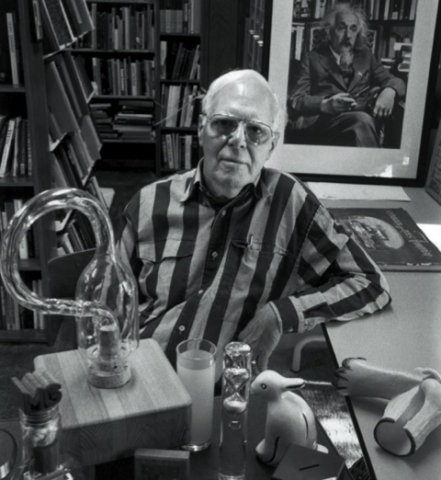Have you heard of M.C. Escher? Origami?
The widespread popularity of these and many other intellectual staples of popular culture is largely due to one man: Martin Gardner.
 He is said to have created more mathematicians than any other person in history, through his numerous books and long-running recreational math column in Scientific American. Widely revered among mathematicians, Gardner passed away in 2010. However his influence and legacy continue to inspire us to approach seemingly intractable problems from unconventional angles.
He is said to have created more mathematicians than any other person in history, through his numerous books and long-running recreational math column in Scientific American. Widely revered among mathematicians, Gardner passed away in 2010. However his influence and legacy continue to inspire us to approach seemingly intractable problems from unconventional angles.
"Gardner's greatest skill was his ability to communicate complex mathematical ideas to the layperson," said math graduate student Cyrus Hettle. "His books and especially his long-running column in Scientific American are full of ideas that are central to modern mathematics, but Gardner – whose mathematical education never went beyond calculus – made them accessible to anyone with a high school mathematics education."
"Gardner also presented mathematics in a truly multidisciplinary way. Not only did he explain mathematics using puzzles, games, and magic tricks, he found mathematics and mathematical ideas in poetry and art," Hettle explained.
The Celebration of Mind is an international celebration of Gardner, who would have turned 100 this year. "This is the fourth Celebration of Mind at UK, and I'm excited to be a part of this global event," said Hettle, who is heading up this year's festivities.
There are over 80 events worldwide, on every continent except Antarctica. UK's event will be on Monday, November 3, from 4:45 to 5:45 p.m. at the Math House. Refreshments will be served, as well as confections for the mind - all the mathematical games, puzzles, and magic tricks one can imagine to honor the contributions of Gardner.
Faculty, students, and all others with an interest in mathematics are invited to attend!
 He is said to have created more mathematicians than any other person in history, through his numerous books and long-running recreational math column in Scientific American. Widely revered among mathematicians, Gardner passed away in 2010. However his influence and legacy continue to inspire us to approach seemingly intractable problems from unconventional angles.
He is said to have created more mathematicians than any other person in history, through his numerous books and long-running recreational math column in Scientific American. Widely revered among mathematicians, Gardner passed away in 2010. However his influence and legacy continue to inspire us to approach seemingly intractable problems from unconventional angles.
